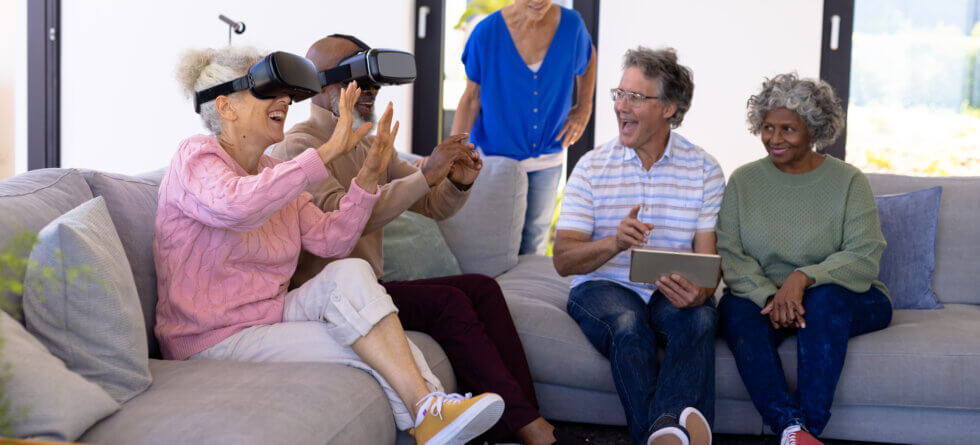In the realm of senior living, the advent of augmented reality (AR) and virtual reality (VR) is ushering in a revolutionary era. These technologies, once the purview of gamers and tech enthusiasts, are now making significant inroads into the daily lives of older adults. In this exploration, we discover how AR and VR are not just changing but enhancing the way our seniors live, learn, and connect.
Understanding AR and VR
Before delving into their impacts on senior living, it’s crucial to distinguish between the two technologies. Augmented reality (AR) layers computer-generated enhancements atop an existing reality, enriching the user’s interaction with the real world. Virtual reality (VR), on the other hand, transports the user into an entirely different, fully immersive digital environment.
Fitness and Rehabilitation
Fitness and health are paramount concerns in senior living facilities. With VR, residents can engage in various physical activities that transcend the boundaries of their immediate surroundings. Through the use of VR headsets, seniors can take virtual bike rides through remote countryside, participate in tai chi on a tranquil beach, or practice yoga in a serene forest – all from the safety and comfort of their residence.
In terms of rehabilitation, AR and VR serve as potent tools. AR applications assist with cognitive rehabilitation through interactive exercises that stimulate the brain in a controlled manner. VR holds promise for physical rehab, enabling individuals to perform guided exercises that can be adjusted to meet their specific therapeutic needs. It allows for precise tracking of progress and the ability to tailor experiences to the individual’s recovery rate.
Social Interaction and Entertainment
The issue of social isolation plagues many seniors, but AR and VR provide compelling solutions. Virtual reality can place an individual in a concert hall, a family gathering, or a reunion with old friends, all while they physically remain in their living quarters. This ability to connect with events and loved ones, despite distance or mobility challenges, is revolutionary.
AR also enhances entertainment and engagement, offering a new dimension to traditional games like board games, puzzles, and card games that are popular in senior communities. These enriched experiences can lead to increased interaction and cognitive stimulation, which are vital components of a healthy aging process.
Memory Care and Dementia Support
For those grappling with memory loss or dementia, VR provides a unique avenue for memory care. It can recreate familiar environments from the past or offer soothing experiences that may help in managing the symptoms of dementia. Simulating calm settings can contribute to reduced anxiety and agitation, common challenges faced by those with memory impairment.
AR applications support memory care by labelling everyday items and providing real-time reminders for tasks, thereby helping individuals maintain a level of independence.
Education and Lifelong Learning
Learning is a never-ending process, and VR makes it even more engaging for seniors. It allows them to visit virtual museums, experience historical events, or even attend lectures at international universities without leaving their homes. This ongoing intellectual enrichment is not only enjoyable but also essential for brain health.
Overcoming Mobility Challenges
Mobility can be a significant constraint for many older individuals. VR and AR give seniors the chance to break free from these limitations, allowing them to explore and interact with worlds that would otherwise be inaccessible. Whether it’s a stroll in a virtual park or AR-driven exercises to improve motor skills, these technologies are enabling seniors to experience mobility in new, adaptable ways.
The Comfort of Connectivity
Technology once seemed a barrier, but AR and VR are bridging the gap between generations. Families can now connect with senior members through shared virtual experiences, fostering a sense of closeness despite physical distance. While nothing replaces human touch and face-to-face interaction, these tools are vital in offering the next best thing.
Training and Support for Caregivers
Beyond direct benefits to seniors, AR and VR offer substantial support to caregivers as well. These technologies provide platforms for training, using simulations to demonstrate the complexities of senior care. VR can simulate real-world scenarios that caregivers might encounter, allowing them to practice their response in a controlled environment before facing actual challenges.
Ethical Considerations and Privacy
With every technology, ethical considerations and questions of privacy follow close behind. In implementing AR and VR in senior living, it is paramount to consider issues like informed consent, data security, and the potential impacts of replacing human interaction with digital experiences. Seniors and their caretakers must be educated on how to use these technologies safely and responsibly.
Looking to the Future
As we look to the future, AR and VR will likely become even more integrated into senior living, with innovations making these technologies more affordable and accessible. From virtual travel and socialization to sophisticated healthcare applications, the possibilities are boundless. However, we must proceed with a careful, informed approach to ensure these developments fully enhance, rather than detract from, the quality of life for our elders.
Conclusion
The use of AR and VR in senior living is both a reflection of our technological advancements and a frontier of untapped potential. These tools are revolutionizing fitness, rehabilitation, social interaction, memory care, education, and caregiver support in the context of senior living. As we embrace these changes, it is imperative to do so with mindfulness, ensuring the ethical application of these powerful tools. With the right balance, augmented aging can open a world of possibilities, rendering the senior living experience richer, more engaging, and infinitely more connected.




